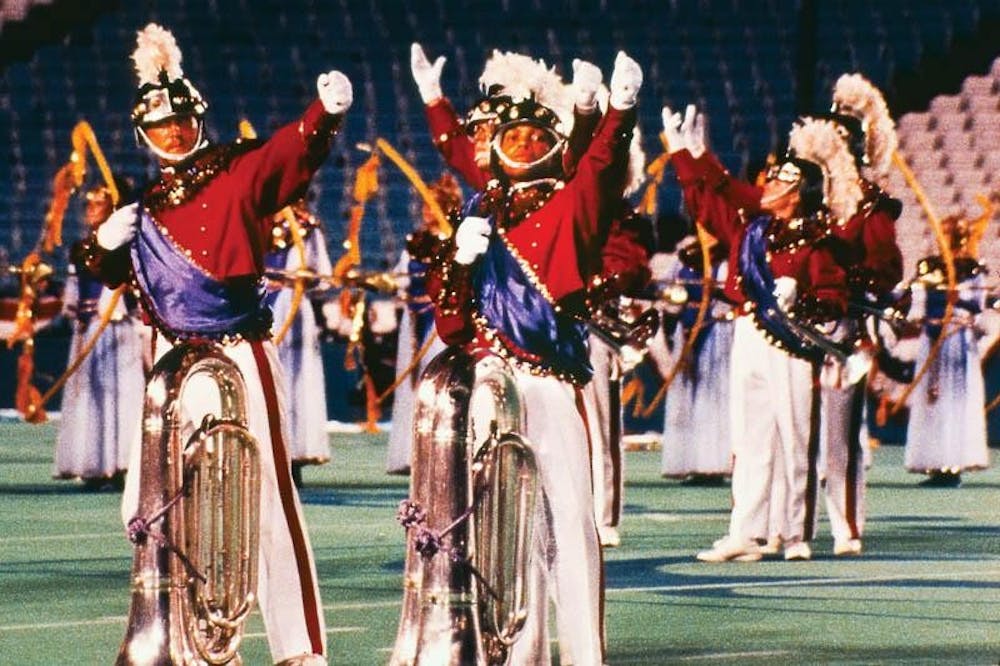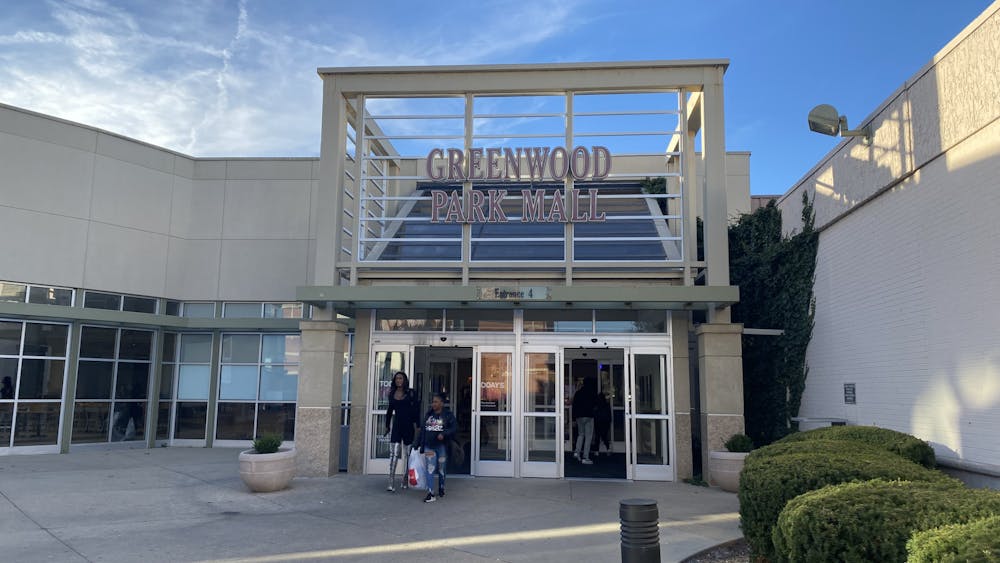As Drum Corps International’s World Championships draw drum corps from all over the world to compete in Bloomington this week, members of the community can proudly gaze back in time at the short, unsurpassed history of one of the league’s greatest drum and bugle corps, Bloomington-based Star of Indiana.
In the realm of drum and bugle corps, most corps have histories dating back several decades, but Star sprang forth in 1984. It was founded by Bloomington billionaire Bill Cook and directed by drum corps veteran James Mason, whom Cook hired from the Iowa Colts.
“At that particular time, I wasn’t sure I wanted to leave The Colts,” Mason said. “But I was so impressed with Bill as a person, and I saw how committed he was.”
With $1 million in sponsorship from Cook Inc., they hired first-rate staff and purchased buses and rehearsal space. Star went to the DCI finals all nine summers of its competitive involvement, won the championship in 1991, and left DCI in 1993 with a legacy of pushing boundaries in every aspect of drum-corps competition. No corps in history has ever been so successful in so short a time.
“Every time we went out, it was not about getting points to win or compete. We did our best. It was about competing against yourself, to do your best, and having everything perfect in every single show,” said LeAnn Scacco, who was in the Star color guard from 1991-1993.
“To start a group from scratch with no skeletons in the closet was a rare and wonderful opportunity to pick our staff and really decide what our values were,” Mason said.
With only 14 experienced members in Star’s first corps, time was of the utmost value. As director, Mason coordinated logistics of summer-long tours, including transporting 170 people and food in four buses and support trucks.
Like performing, good organization took practice. They practiced loading and unloading. Mason even faked a bus breakdown.
That first summer, Star made the final 12 at the season-ending championships and came in 10th overall, a success unheard for any drum corps’ first tour, and one that was greeted with some jealousy by other corps, many of which lacked the financial stability that Star enjoyed.
THE FORMULA
By 1987, Mason realized the corps had the potential to be a winning, unique force within DCI. He devised a three-step formula for success: “play the game, win the game, change the game.” That year, he decided to “play the game,” meaning Star would “develop a strong technical foundation.” Step two was to “win the game,” which they did in 1991.
“I had to push them beyond what they thought they could do,” said Mason. “If you think you can or can’t do something, then you’re probably right.”
And in the final two years of the corps, Mason implemented the final step and “changed the game.”
Fresh out of high school, percussionist Tony Lymon saw Star live at the DCI South Preliminaries in Birmingham, Ala. in summer 1990.
“When they did the opening strains of Belshazzar, I was completely won over,” Lymon said. “I turned to the guy next to me and said, ‘I’m going to be in that drum corps next year.’”
With no car and no money, he sold everything to finance his trips to Bloomington. The pressure was intense.
“When you go for those winter camps, you’re not in the corps until you get on the first bus for the first show. You have to constantly prove that you deserve that spot,” Lymon said.
That summer, days before an event in Boston, the corps went through a harrowing process, changing the routine’s final 30 seconds. Known as the “cross-on-cross,” the closing presented the juxtaposition of two crosses in succession and alluded to the pairing of Old and New Testaments, Mason said.
The logistics were torturous for visual director George Zingali.
“We didn’t have the ending correct. It just wasn’t our best,” Mason said.
FINDING IT
Zingali lamented to Mason that he “didn’t have it.” Finally, Zingali returned to the corps, and in sudden inspiration, he turned the tables. He had them separate into groups and choreograph themselves. Mason recalled the subsequent moments as something truly special.
“What I saw that night, it was like a classical musician suddenly learned about improvisation in jazz. And it was a magical moment,” said Mason. “What they created that night was something I had never witnessed. (Zingali) was like a young boy that night.”
That summer, in its sixth tour, Star became the youngest corps to win the world championships.
“That was the greatest summer of my life,” said Lymon.
Once Star “won the game” in 1991, Mason strove to “change the game,” and break new ground.
“To change the game meant we were going to leave our own individual fingerprint on the activity, and set a bar of creative standard that the group would always be known for,” he said.
RAISING THE CEILING
Star raised the ceiling in 1993 with a program titled “Medea” with music by Bela Bartok and Samuel Barber. The color guard danced balletic choreography and carried long poles and gigantic silver isosceles triangles instead of flags. The discordant music was unconventionally somber, and some protested Star’s second-place finish.
“I think anyone you talk to will agree that the show we did changed the face of drum corps,” said Lymon. “The focus was solely on excellence.”
After Star’s short triumphant stint in DCI from 1984 to 1993, Cook and Mason shifted focus to producing a full-length concert program via Brass Theater.
“Drum corps is a wonderful, wonderful activity,” said Mason. “But when Star of Indiana was there, there was a lot of envy and not so many positive things for Bill and his company. The best thing was to play professional venues.”
Brass Theater first toured in 1994 in collaboration with the professional ensemble Canadian Brass, performing in major venues like Tanglewood, Wolf Trap and Lincoln Center. Always pushing the envelope, Brass Theater soon evolved into the Emmy- and Tony-award-winning Broadway show “Blast!,” which debuted in London in 1999 and featured the defining elements of drum corps on a theater stage, complete with light effects and all the showmanship to dazzle a modern-day audience.
“It was spine-tingling awesome to see parts of what I had done on the field put onstage,” said Scacco, who saw Blast! in Chicago five years ago. “This was the essence of drum corps on stage.”
IN OUR BLOOD
Without Star of Indiana, DCI has continued to draw young people from ages 15 to 21 into its ranks of brass, percussion and color guard.
Alumni of Star of Indiana call each other lifelong friends. Many wed fellow drum corps alumni, and a striking number of them became musicians and music educators, often staying in the drum corps circuit as staff, parents or die-hard fans. They recall Cook as a warm, unassuming father-figure.
“He would sit on the sidewalk with us and eat shepherd’s pie,” said Lymon of Cook. “He looked at us like we were his kids. I can’t say enough nice things about the guy.”
Most agree that the drum corps life – living off buses, showering irregularly and eating meals on street curbs – is far from glamorous. Yet something intangible and far stronger than material desires beckons them back to the corps year after year.
“It’s in our blood, man,” Scacco laughed. “It’s a passion for music, for movement and knowing that you’re with the best of the best.”
'When you wish upon a Star'

Get stories like this in your inbox
Subscribe





